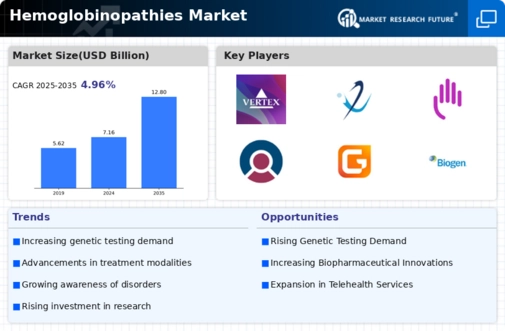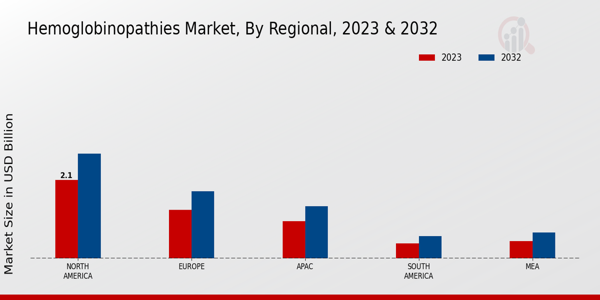Market Growth Projections
The Global Hemoglobinopathies Market Industry is projected to experience a compound annual growth rate (CAGR) of 5.42% from 2025 to 2035. This growth trajectory is indicative of the increasing demand for diagnostic and therapeutic solutions as awareness and prevalence of hemoglobinopathies rise. The market is expected to evolve significantly, with innovations in treatment options and advancements in healthcare delivery. By 2035, the market could reach 12.8 USD Billion, reflecting the ongoing efforts to address the challenges posed by these genetic disorders. Such projections underscore the potential for continued investment and development in this critical area of healthcare.
Growing Awareness and Education Initiatives
Awareness and education initiatives regarding hemoglobinopathies are gaining momentum globally, thereby influencing the Global Hemoglobinopathies Market Industry. Campaigns aimed at educating healthcare professionals and the general public about the signs, symptoms, and management of these disorders are crucial. Organizations and governments are increasingly collaborating to disseminate information, which may lead to earlier diagnosis and treatment. This heightened awareness is expected to drive demand for diagnostic tools and therapies, contributing to market growth. As more individuals become informed, the likelihood of seeking medical intervention increases, further propelling the industry.
Increasing Prevalence of Hemoglobinopathies
The Global Hemoglobinopathies Market Industry is witnessing a surge in the prevalence of conditions such as sickle cell disease and thalassemia. According to the World Health Organization, millions of individuals are affected by these disorders globally, particularly in regions like Africa and Southeast Asia. This rising incidence is likely to drive demand for diagnostic and therapeutic solutions, contributing to market growth. The increasing awareness and screening initiatives in various countries further amplify this trend, suggesting a robust market potential as healthcare systems strive to address these genetic disorders.
Advancements in Genetic Testing Technologies
Technological innovations in genetic testing are transforming the Global Hemoglobinopathies Market Industry. Enhanced methods such as next-generation sequencing and CRISPR-based diagnostics are enabling more accurate and rapid identification of hemoglobinopathies. These advancements not only facilitate early diagnosis but also improve patient management strategies. As healthcare providers increasingly adopt these technologies, the market is expected to expand significantly. The integration of genetic testing into routine clinical practice may lead to better patient outcomes and a more personalized approach to treatment, thereby fostering market growth.
Rising Investment in Research and Development
Investment in research and development within the Global Hemoglobinopathies Market Industry is on the rise, driven by both public and private sectors. Governments and pharmaceutical companies are focusing on developing novel therapies and treatment modalities for hemoglobinopathies. This trend is evidenced by the increasing number of clinical trials and the introduction of innovative therapies. By 2035, the market is projected to reach 12.8 USD Billion, reflecting the potential of R&D investments to yield effective solutions for patients. Such financial commitments are likely to enhance the therapeutic landscape and improve overall patient care.
Expansion of Healthcare Infrastructure in Developing Regions
The expansion of healthcare infrastructure in developing regions is a pivotal driver for the Global Hemoglobinopathies Market Industry. As countries invest in healthcare facilities and services, access to diagnosis and treatment for hemoglobinopathies improves significantly. This trend is particularly evident in regions with high prevalence rates, where enhanced healthcare systems can facilitate early detection and management of these disorders. By 2024, the market is anticipated to reach 7.16 USD Billion, reflecting the impact of improved healthcare access on patient outcomes. Such developments are likely to stimulate demand for related healthcare products and services.
























